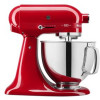KitchenAid KSM180QHSD Owners Manual - Page 13
Mixing Tips
 |
View all KitchenAid KSM180QHSD manuals
Add to My Manuals
Save this manual to your list of manuals |
Page 13 highlights
ENGLISH TIPS FOR GREAT RESULTS MIXING TIPS Mixing time Your KitchenAid Stand Mixer will mix faster and more thoroughly than most other electric mixers. Therefore, the mixing time in most recipes must be adjusted to avoid over beating. To help determine the ideal mixing time, observe the batter or dough and mix only until it has the desired appearance described in your recipe, such as "smooth and creamy." To select the best mixing speeds, use the "Speed control guide" section. Adding ingredients The standard procedure to follow when mixing most batters, especially cake and cookie batters, is to add: 1/3 dry ingredients 1/2 liquid ingredients 1/3 dry ingredients 1/2 liquid ingredients 1/3 dry ingredients Use Speed 1 until ingredients have been blended. Then gradually increase to desired speed. Always add ingredients as close to side of bowl as possible, not directly into moving beater. The pouring shield can be used to simplify adding ingredients. NOTE: If ingredients in very bottom of bowl are not thoroughly mixed, the beater is not far enough into the bowl. See the "Beater to bowl clearance" section. Cake mixes When preparing packaged cake mixes, use Speed 4 for medium speed and Speed 6 for high speed. For best results, mix for the time stated on the package directions. Adding nuts, raisins, or candied fruits Solid materials should be folded in the last few seconds of mixing on Speed 1. The batter should be thick enough to keep the fruit or nuts from sinking to the bottom of the pan during baking. Sticky fruits should be dusted with flour for better distribution in the batter. Liquid mixtures Mixtures containing large amounts of liquid ingredients should be mixed at lower speeds to avoid splashing. Increase speed only after mixture has thickened. Kneading yeast doughs ALWAYS use the dough hook to mix and knead yeast doughs. Use Speed 2 to mix or knead yeast doughs. Use of any other speed creates high potential for unit failure. Do not use recipes calling for more than 7 cups (900 g) all-purpose flour or 6 cups (800 g) whole-wheat flour when making dough in a 4.28 L bowl. Do not use recipes calling for more than 8 cups (1 kg) all-purpose flour or 6 cups (800 g) whole-wheat flour when making dough in a 4.8 L bowl. TIPS FOR GREAT RESULTS | 13















